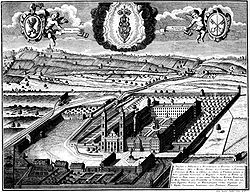Weissenau
| Imperial Abbey of Weissenau | ||||||||
| Reichsstift Weißenau | ||||||||
| Imperial Abbey of the Holy Roman Empire | ||||||||
|
||||||||
|
Engraving of Weissenau Abbey, Johann Mathias Steidlin, 1734
|
||||||||
| Capital | Weißenau | |||||||
| Languages | Alemannic German | |||||||
| Religion | Roman Catholicism | |||||||
| Government | Elective principality | |||||||
| Historical era | Middle Ages | |||||||
| • | Founded | 1145 | ||||||
| • | Raised to abbey | 1257 | ||||||
| • | Gained Reichsfreiheit | mid-to-late 13th century | ||||||
| • | Received Precious Blood from Rudolph of Habsburg |
1283 |
||||||
| • | Joined Council of Princes | 1793 | ||||||
| • |
Secularised to Sternberg- Manderscheid |
1802 | ||||||
| • | Bought by Württemberg | 1835 | ||||||
|
||||||||
Weissenau Abbey (German: Kloster Weißenau, Reichsstift Weißenau) was an Imperial abbey (Reichsabtei) of the Holy Roman Empire located near Ravensburg in the Swabian Circle. The abbey, a Premonstratensian monastery, was an Imperial Estate and therefore its abbot had seat and voice in the Reichstag as a prelate of the Swabian Bench. The abbey existed from 1145 until the secularisation of 1802-1803.
The site was originally called Au (Latin: Augia, English: meadow), then Minderau (Augia Minor, lesser meadow), and finally Weissenau (Augia Alba or Candida, white meadow). The monastery was founded in 1145 by Gebizo of Ravensburg, a ministerialis of the Welfs, and his sister Luitgarde. Its first monks and their provost Herman (1145–75) came from Rot an der Rot Abbey near Memmingen. The monastery buildings were completed in 1156, and in 1172 the church was dedicated to Our Lady and Saint Peter by Otto, Bishop of Konstanz, to whose diocese it then belonged. During the first few years of its existence it had a nunnery attached, but this was transferred to Weissenthal nearby by Provost Herman, where it continued and existed there until the 15th century.
The number of canons at Weissenau increased so rapidly that in 1183 the newly founded monastery of Schussenried Abbey was recruited from there. In 1257 Weissenau was raised to the rank of an abbey, with Henry I (1257–66) as its first abbot. It was granted the status of an "Imperial abbey" (i.e., territorially independent) about this time.
...
Wikipedia

